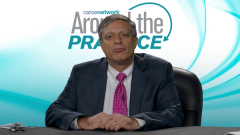
Choosing the Right Treatment for Patients With Transplant Ineligible MM
Patient and disease factors that help to select best first-line therapy in the setting of transplant-ineligible multiple myeloma.
Episodes in this series

Transcript:
Sagar Lonial, MD: We’ve talked around the big question. Let’s call them frail patients, instead of transplant ineligible, because that’s how I make decisions in terms of what I’m going to do. We all agree that lenalidomide-dexamethasone is in the regimen. The question is whether you’re going to partner a CD38 or a PI [proteasome inhibitor] with it. How do you go through that? How do we help our colleagues in the community make those decisions?
Timothy Schmidt, MD: Neither is wrong. There are pros and cons to each approach. I’ve become much more a fan of the daratumumab-lenalidomide-dexamethasone regimen. Basically, it has very low rates of peripheral neuropathy, lower risks of falls, and good long-term data from the MAIA study. Patients love being on this regimen. It’s so easy and so well tolerated; you can stay on it. In terms of modifying that continuous therapy, you have 2 drugs that you could use as ongoing therapy if you need to. That’s what I’ve been more drawn to as I’ve been in clinical practice.
Sandy Wong, MD: I completely agree. When you look at the rates of neuropathy and the grade on a trial—we call grade 1 and 2 low-grade neuropathy, but having grade 2 neuropathy is awful. It’s especially awful for someone who is already frail, is prone to falls, and has gait imbalance, and then you’re adding neuropathy on top of that. I’m also with you in that sense that I’m also a MAIA girl.
Samuel M. Rubinstein, MD: To another point, frailty has functional and logistical components. Getting to infusion centers is challenging for these patients. I’ve seen that argument from both sides. RVd [lenalidomide, bortezomib, dexamethasone] involves more frequent infusions, but if you follow the SWOG paradigm, it involves eventually dropping bortezomib. The thing about MAIA is that it goes biweekly after 2 cycles and then monthly after that. It’s easy for most patients. That’s the frequency at which they need to see us anyway. I choose regimens that keep patients away from my infusion center. I think my patients like me, but the best days of their lives are days they don’t have to see me. That enters my decision-making for how to take care of our frail patients with multiple myeloma.
Caitlin Costello, MD: If you’re in Europe, you get daratumumab at home. In terms of making it easier, if we could only get to that point. One question that will always come up is, what about those high-risk frail patients? The reality is that bortezomib is a good drug for high-risk disease. We have to understand that when we’re thinking about treatment options, we’re taking in patient-related factors—neuropathy, treatment-related toxicities—but we also have to figure out how to add the biology of disease into that treatment decision-making process. I don’t know if we know that answer yet. But I agree with all of you. My preference is for daratumumab or daratumumab–Rd [lenalidomide, dexamethasone].
Samuel M. Rubinstein, MD: There are ongoing trials looking at this concept. But the frail–high-risk overlap is tricky. Proteasome inhibitors are important in patients with high-risk myeloma. Attenuated quads could be an answer. Giving bortezomib at lower doses or less frequently, or for a defined interval of time, could potentially overcome some of the high-risk disease biology and offer patients benefit—even those who are frail and ineligible for transplant.
Sagar Lonial, MD: Fortunately, high-risk patients seem to be less enriched in the older population. You have a higher proportion of hyperdiploid patients, so it’s less of an issue. Certainly, I think about a modified VRd [bortezomib, lenalidomide, dexamethasone] for the patient who presents with 17p deletion because I know what that track record looks like. But it’s an open question.
Transcript edited for clarity.
Newsletter
Stay up to date on recent advances in the multidisciplinary approach to cancer.




















































































